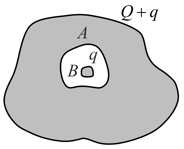HARD
12th Assam Board
IMPORTANT
Earn 100
An oil drop of excess electrons is held stationary under a constant electric field of (Millikan’s oil drop experiment). The density of the oil is . Estimate the radius of the drop. (; ).

Important Questions on Electric Charges and Fields
HARD
12th Assam Board
IMPORTANT
Which among the curves shown in the figure cannot possibly represent electrostatic field lines?

HARD
12th Assam Board
IMPORTANT
In a certain region of space, electric field is along the -direction throughout. The magnitude of the electric field is, however, not constant but increases uniformly along the positive -direction, at the rate of per meter. What are the force and torque experienced by a system having a total dipole moment equal to in the negative -direction?
EASY
12th Assam Board
IMPORTANT
A conductor with a cavity as shown in figure is given a charge . Show that the entire charge must appear on the outer surface of the conductor.

MEDIUM
12th Assam Board
IMPORTANT
A conductor with cavity as shown in the figure is given a charge . Another conductor with charge is inserted into the cavity keeping insulated from . Show that the total charge on outside the surface of is .

EASY
12th Assam Board
IMPORTANT
A sensitive instrument is to be shielded from the strong electrostatic fields in its environment. Suggest a possible way.
HARD
12th Assam Board
IMPORTANT
A hollow charged conductor has a tiny hole cut into its surface. Show that the electric field in the hole is ( ) , where is the unit vector in the outward normal direction, and is the surface charge density near the hole.
HARD
12th Assam Board
IMPORTANT
Obtain the formula for the electric field due to a long thin wire of uniform linear charge density without using Gauss’s law. [Hint: Use Coulomb’s law directly and evaluate the necessary integral.]
MEDIUM
12th Assam Board
IMPORTANT
It is now believed that protons and neutrons (which constitute nuclei of ordinary matter) are themselves built out of more elementary units called quarks. A proton and a neutron consist of three quarks each. Two types of quarks, the so called ‘up’ quark (denoted by ) of charge and the ‘down’ quark (denoted by ) of charge together with electrons build up ordinary matter. (Quarks of other types have also been found which give rise to different unusual varieties of matter.) Suggest a possible quark composition of a proton and neutron.
